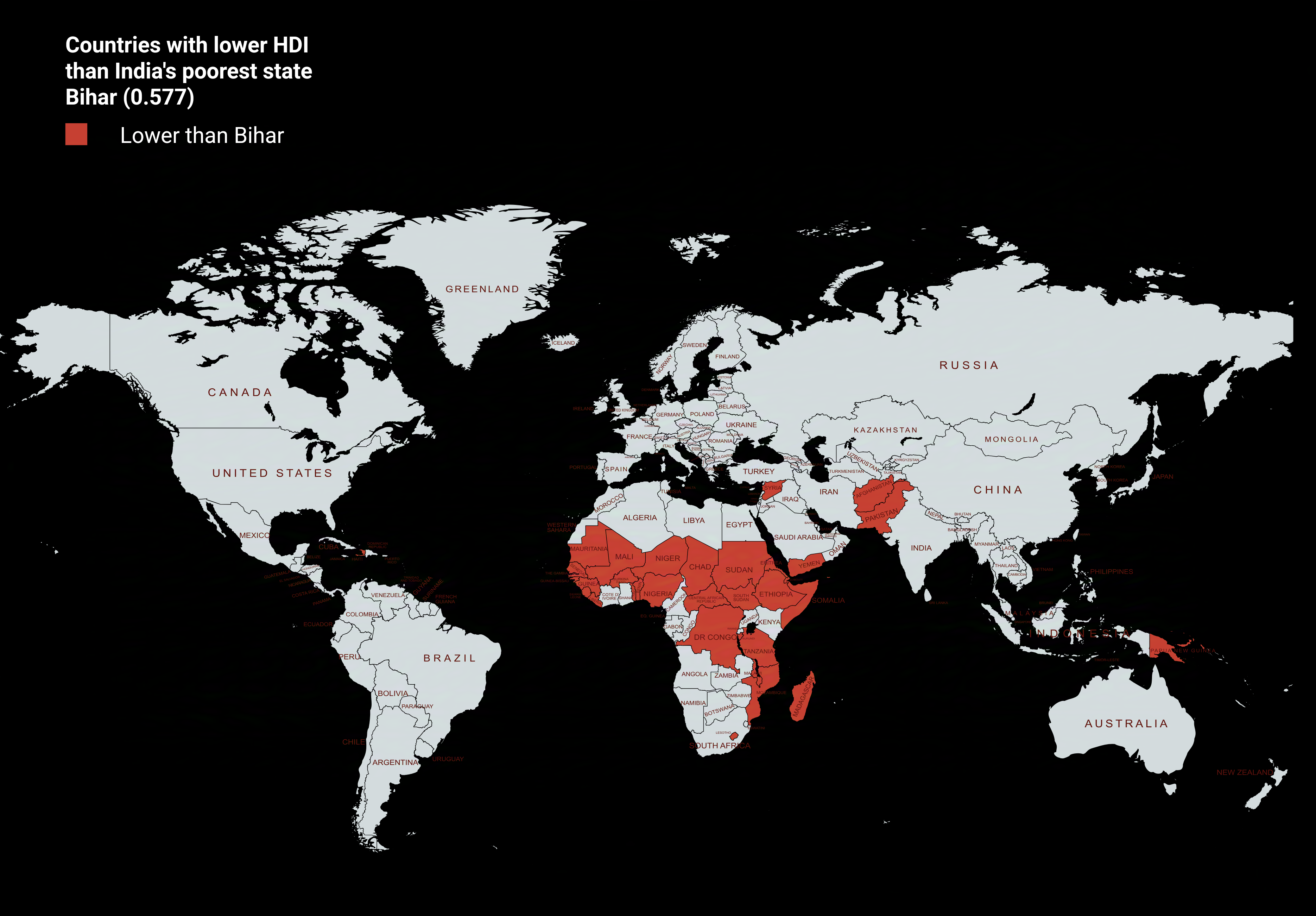

Alex Cartwright
Senior Cartographer & GIS Specialist
Alex Cartwright is a renowned cartographer and geographic information systems specialist with over 15 years of experience in spatial analysis and data...
Geographic Analysis
What This Map Shows
The visualization titled "Countries with Lower HDI than Bihar Map" provides a stark comparison of human development across the globe by highlighting nations that fall beneath the Human Development Index (HDI) of Bihar, India's poorest state. HDI is a composite index that takes into account health, education, and standard of living indicators, serving as a crucial measure of a country's social and economic development. This map effectively illustrates the disparities in human development by pinpointing countries that, despite their geographical and cultural differences, share a similar or lower HDI than Bihar.
Deep Dive into Human Development Index
The Human Development Index is a vital tool used to assess the quality of life and development in different regions. The HDI is calculated based on three primary dimensions: life expectancy at birth, education (measured by mean years of schooling and expected years of schooling), and gross national income (GNI) per capita. Interestingly, Bihar's HDI has been estimated at around 0.586, categorizing it as a state with low human development.
This puts it in a unique position when compared to countries globally, as many nations with lower HDI scores face significant challenges. For instance, countries like Afghanistan, Chad, and Niger, which have HDI scores below that of Bihar, grapple with issues such as poverty, limited access to healthcare, and inadequate educational systems. Afghanistan, for example, has been struggling to recover from decades of conflict, which heavily impacts its development indicators.
Moreover, environmental factors play a crucial role in shaping HDI scores. Countries in sub-Saharan Africa, such as Malawi and Mozambique, face challenges such as climate change, which exacerbates food insecurity and health crises. Their lower HDI scores are often reflective of such systemic issues, including political instability and economic constraints.
However, it's fascinating to observe that not all nations with lower HDI scores are in dire circumstances. Some, like Haiti, despite their struggles, exhibit a vibrant culture and resilience among their people. This underlines the importance of understanding HDI not just as a statistical measure, but as a reflection of human stories and experiences.
Regional Analysis
When examining the countries with lower HDI than Bihar, we can categorize them into various regions. For example, in Africa, many countries such as Burundi and Sierra Leone show HDI scores that align closely with Bihar’s. In these regions, factors such as civil unrest, economic challenges, and health crises have significantly hampered development. Conversely, some countries in South Asia, like Nepal and Bangladesh, have made strides in improving their HDI, reflecting the impact of economic growth and educational reforms.
In the Middle East, nations like Yemen stand out due to their ongoing conflicts that have led to deteriorating living conditions and human development indicators. In contrast, certain Caribbean nations exhibit lower HDI scores, yet they often maintain a higher standard of living relative to their HDI rankings due to tourism and remittances from abroad.
What’s especially interesting is the variation within regions. For instance, while most of sub-Saharan Africa struggles with lower HDI scores, some countries like Ghana and Senegal are making progress, showcasing how governance and policy changes can lead to improved outcomes.
Significance and Impact
Understanding the HDI landscape in relation to Bihar not only sheds light on global inequalities but also emphasizes the urgency for international cooperation and support. As we face challenges like climate change and public health crises, the importance of human development cannot be overstated. Countries with low HDI suffer from a lack of resources and infrastructure, which is compounded by global issues such as pandemics and economic downturns.
Recognizing these disparities can drive policy decisions at both national and international levels, pushing for improvements in education, healthcare, and economic development. Additionally, as we look toward the future, it’s crucial that nations learn from each other’s successes and failures. By fostering partnerships and sharing best practices, countries can improve their HDI and enhance the quality of life for their citizens.
In conclusion, the map of countries with lower HDI than Bihar provides more than just geographical data; it represents a call to action to address inequalities and promote human development worldwide. What steps can we take to uplift these communities? How can we ensure that development is inclusive and sustainable? These questions are vital as we move forward in a world interconnected by shared challenges and aspirations.
Visualization Details
- Published
- September 14, 2025
- Views
- 84
Comments
Loading comments...